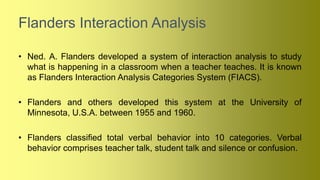Dr. Pooja Walia's presentation on interaction analysis covers the definitions, types, and characteristics of classroom interaction, emphasizing its role in enhancing student skills and teacher-student relationships. The Flanders Interaction Analysis Categories System (FIACS) is highlighted for its systematic observation of verbal interactions in the classroom, categorizing behaviors into teacher and pupil talk. While FIACS offers valuable insights and reliable observations, it also has limitations, such as being time-consuming and focusing less on pupil interactions.







































